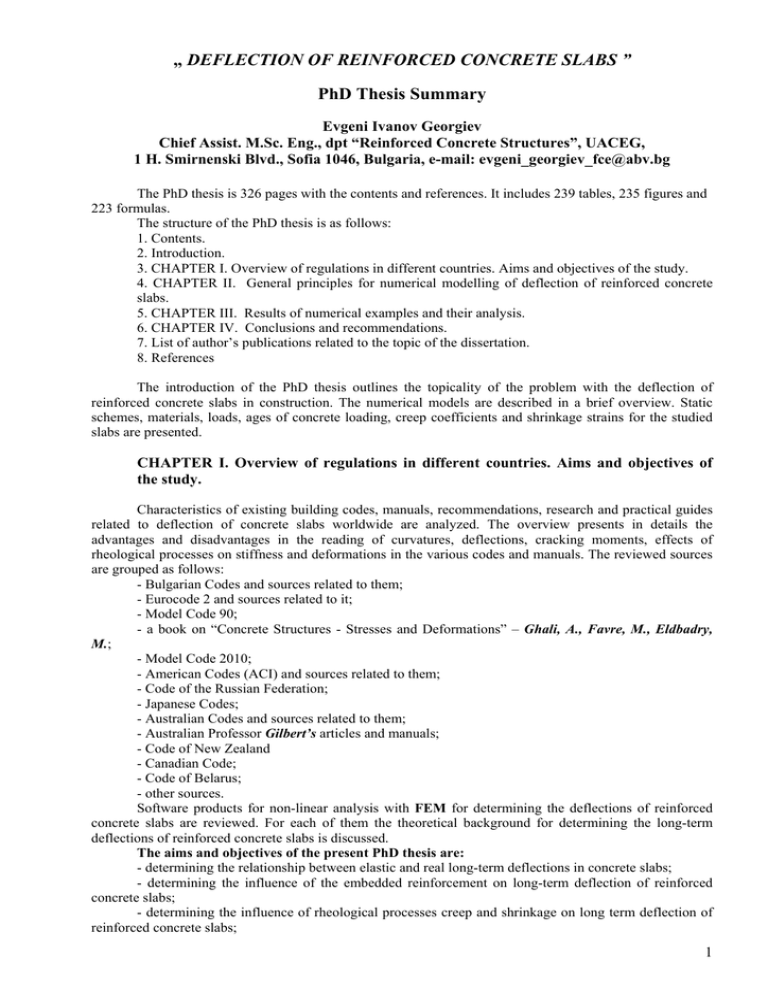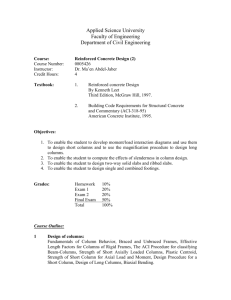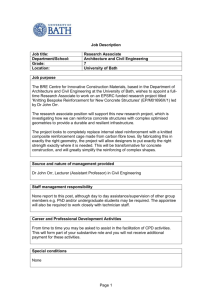DEFLECTION OF REINFORCED CONCRETE SLABS ” PhD Thesis Summary
advertisement

„ DEFLECTION OF REINFORCED CONCRETE SLABS ” PhD Thesis Summary Evgeni Ivanov Georgiev Chief Assist. M.Sc. Eng., dpt “Reinforced Concrete Structures”, UACEG, 1 H. Smirnenski Blvd., Sofia 1046, Bulgaria, e-mail: evgeni_georgiev_fce@abv.bg The PhD thesis is 326 pages with the contents and references. It includes 239 tables, 235 figures and 223 formulas. The structure of the PhD thesis is as follows: 1. Contents. 2. Introduction. 3. CHAPTER I. Overview of regulations in different countries. Aims and objectives of the study. 4. CHAPTER II. General principles for numerical modelling of deflection of reinforced concrete slabs. 5. CHAPTER III. Results of numerical examples and their analysis. 6. CHAPTER IV. Conclusions and recommendations. 7. List of author’s publications related to the topic of the dissertation. 8. References The introduction of the PhD thesis outlines the topicality of the problem with the deflection of reinforced concrete slabs in construction. The numerical models are described in a brief overview. Static schemes, materials, loads, ages of concrete loading, creep coefficients and shrinkage strains for the studied slabs are presented. CHAPTER I. Overview of regulations in different countries. Aims and objectives of the study. Characteristics of existing building codes, manuals, recommendations, research and practical guides related to deflection of concrete slabs worldwide are analyzed. The overview presents in details the advantages and disadvantages in the reading of curvatures, deflections, cracking moments, effects of rheological processes on stiffness and deformations in the various codes and manuals. The reviewed sources are grouped as follows: - Bulgarian Codes and sources related to them; - Eurocode 2 and sources related to it; - Model Code 90; - a book on “Concrete Structures - Stresses and Deformations” – Ghali, A., Favre, M., Eldbadry, M.; - Model Code 2010; - American Codes (ACI) and sources related to them; - Code of the Russian Federation; - Japanese Codes; - Australian Codes and sources related to them; - Australian Professor Gilbert’s articles and manuals; - Code of New Zealand - Canadian Code; - Code of Belarus; - other sources. Software products for non-linear analysis with FEM for determining the deflections of reinforced concrete slabs are reviewed. For each of them the theoretical background for determining the long-term deflections of reinforced concrete slabs is discussed. The aims and objectives of the present PhD thesis are: - determining the relationship between elastic and real long-term deflections in concrete slabs; - determining the influence of the embedded reinforcement on long-term deflection of reinforced concrete slabs; - determining the influence of rheological processes creep and shrinkage on long term deflection of reinforced concrete slabs; 1 - conclusions and recommendations for the calculation of deflections of reinforced concrete slabs; - conclusions and recommendations for further development and improvement of the building regulations. CHAPTER II. General principles for numerical modelling of deflection of reinforced concrete slabs. Comparisons of the tensile strength of concrete, cracking moments, modulus of elasticity of concrete and tensioning stiffening according to Bulgarian codes, Russian Codes, Eurocode 2 and American codes (ACI) are carried out, as well as analyses and recommendations on their use. When determining the deflection of reinforced concrete slabs, the following assumptions are made: 1. The cracking moment has been determined including the embedded reinforcement; 2. The cracking moment has been calculated with the mean value of axial tensile strength of concrete f ctm according to Eurocode 2; 3. The minimum cross sectional area of reinforcement As,min is according to Eurocode 2; 4. The final value of creep coefficient ϕ (t = ∞, t 0 ) has been calculated according to Eurocode 2 where for creep of concrete a period of 70 years (25 550 days) is adopted and the ambient relative humidity is RH = 50 % ; 5. The dissertation discusses ages of concrete at loading after 28 days. For all numerical examples of reinforced concrete slabs the following ages of concrete at loading are adopted: - t1 = 28 days is the age of concrete when the characteristic value of self weight of slab g1k has been applied; - t 2 = 100 days is the age of concrete when other characteristic permanent (dead) loads g 2k = 3,00 kN/m 2 have been applied; - t 3 = 550 days is the age of concrete when quasi permanent live load g 2k = 3,00 kN/m 2 has been applied. The coefficient that takes into account the part of live load in quasi-permanent combination is ψ 2 = 0,6 . For each of these ages of concrete the corresponding creep coefficients ϕ i (∞, t 0 ) are calculated. After that the equivalent creep coefficient ϕ eq is worked out. This equivalent creep coefficient, which allows taking into account the load history in a simplified manner, is the weighted average rate of creep coefficients. 6. The effective modulus of elasticity of concrete E c,eff has been calculated according to Eurocode 2 with equivalent creep coefficient ϕ eq and ageing coefficient χ = 1,0 for time t = ∞ ; 7. Second time the age-adjusted effective modulus of concrete E c,adj (t , t 0 ) has been worked out according to Model Code 90 and 2010 with equivalent creep coefficient ϕ eq and ageing coefficient χ = 0,8 for time t = ∞ ; 8. The total shrinkage strain ε cs has been worked out according to Eurocode 2 and for shrinkage strain of concrete is adopted a period of 70 years (25 550 days) and ambient relative humidity RH = 50 % ; 9. Plane sections remain plane after loading; 10. The tensile strength of concrete is ignored; 11. It is assumed that the whole loading g1k + g 2 k + ψ 2 q k is applied at time t1 . This means that there will be no change of stiffness of reinforced concrete slabs after the whole loading g1k + g 2 k + ψ 2 q k is applied. The load history in a simplified manner is taken into account with equivalent creep coefficient ϕ eq as you may see in 5. above. 12. The effective moment of inertia I e is determined according to Eurocode 2. The Eurocode 2 approach for I e is one of the best models of cracked concrete elements behaviour according to some authors. 13. The distribution coefficient ζ is used for tensioning stiffening according to Eurocode 2. 14. Firstly, the long-term deflection considering creep and shrinkage of concrete is determined by the effective modulus of elasticity method (EEM) using E c,eff as you may see in 6. above; 15. Secondly, the long-term deflection considering creep and shrinkage of concrete is determined by the age-adjusted effective modulus method (AAEM) using E c,adj (t , t 0 ) as you may see in 7. above; 16. Thirdly, the long term deflection considering creep and shrinkage of concrete is determined by formula (I.18) which is given in Bulgarian and Russian Codes. Short-term deflections are determined by the 2 secant modulus of elasticity of concrete E cm and its relevant effective moment of inertia I e . The long deflections are determined by effective modulus of elasticity of concrete E c,eff (EEM) and its relevant effective moment of inertia I e . The shrinkage deflections are added to the long-term deflection. 17. Fourthly, the long-term deflection considering creep and shrinkage of concrete is determined by formula (I.18) which is given in Bulgarian and Russian Codes. The short-term deflections are determined by the secant modulus of elasticity of concrete E cm and its relevant effective moment of inertia I e . The long deflections are determined by age-adjusted effective modulus of concrete E c,adj (t , t 0 ) (AAEM) and its relevant effective moment of inertia I e . The shrinkage deflections are added to the long-term deflection. The software CSI Safe has been chosen taking into account these considerations. Numerical modeling for examples from the references has been made with the selected software. Comparative analyses have been done between the results from the software and the given source. Nine examples have been compared. Five of them have been solved by hand in sources and the other four have been solved by numerical integration. The static scheme of 7 of them is simple supported elements and the static scheme of the others is one-way reinforced slab with two spans. One way reinforced concrete slabs on beams are modelled in the dissertation. The following static schemes are used: 1. Static scheme 1 – simple supported slabs; 2. Static scheme 2 – one-end fixed slabs; 3. Static scheme 3 – two-end fixed slabs; When determining the deflection of one-way reinforced concrete slabs, the following effective spans L and thicknesses h f of the slabs are used: - effective span L = 8,4 m and static scheme 1 - h f = 38 cm , static scheme 2 - h f = 28 cm , static scheme 3 - h f = 22 cm ; - effective span L = 7,2 m и static scheme 1 - h f = 32 cm , static scheme 2 - h f = 24 cm , static scheme 3 - h f = 20 cm ; - effective span L = 6,0 m и static scheme 1 - h f = 28 cm , static scheme 2 - h f = 20 cm , static scheme 3 - h f = 16 cm . Two-way reinforced concrete slabs on beams with equal effective span in directions X and Y are modelled in the dissertation. The static schemes are according to six cases of Marcus. When determining the deflection of two-way slabs, the following effective spans L x = L y and thicknesses h f of the slabs are used: - effective spans L x = L y = 8,4 m and first case of Marcus h f = 22 cm and h f = 24 cm ; - effective spans L x = L y = 8,4 m and second case of Marcus h f = 22 cm ; - effective spans L x = L y = 8,4 m and third case of Marcus h f = 18 cm ; - effective spans L x = L y = 8,4 m and fourth case Маркус h f = 20 cm ; - effective spans L x = L y = 8,4 m and fifth case of Marcus h f = 22 cm and h f = 18 cm ; - effective spans L x = L y = 8,4 m and sixth case of Marcus h f = 16 cm ; - effective spans Lx = L y = 7,2 m and first case of Marcus h f = 20 cm ; - effective spans L x = L y = 6,0 m and first case of Marcus h f = 16 cm . The deflection of two-way slabs with effective spans L x = L y = 8,4 m has been calculated using two different models. In the first model slabs are modelled like two-way slabs. In the second model slabs are modelled like one-way strips with width 1 meter in directions X and Y . For each strip in each direction the deflection is worked out. The final deflection is calculated as the mean value of the deflection in directions X and Y . The deflection of two-way slabs with effective spans L x = L y = 7,2 m and L x = L y = 6,0 m have been calculated only with the first model. The used materials for the numerical examples are according to Eurocode 2: - for all slabs reinforcing steel grade B500C is used; - for all slabs with effective spans L = 6,0 m concrete grade C20 / 25 is used; - for all slabs with effective spans L = 7,2 m concrete grade C25 / 30 is used; - for all slabs with effective spans L = 8,4 m concrete grade C30 / 37 is used; 3 First the reinforcement for the ultimate limit state (ULS) is designed and with this reinforcement the deflection is calculated. After that the embedded tensile and/or compression reinforcement in the spans and over supports are increased and their influence on the deflection are traced. The influence of creep and shrinkage of concrete on deflection is monitored during the reinforcement change. The difference between elastic and real long-term deflections of reinforced concrete slabs has been found. CHAPTER III. Results of numerical examples and their analysis. Procedures for calculation of creep coefficient and shrinkage strain of concrete according to Eurocode 2 are performed in Microsoft Excel. Only the final results for the equivalent creep coefficient ϕ eq and total shrinkage strain ε cs are presented for all examples. Numerical examples of one- and two-way reinforced concrete slabs on beams are presented. For all one-way reinforced concrete slabs on beams with static scheme 1 and 2 the following four options are made: - the first is with increasing of tensile reinforcement in the span without top reinforcement in the span; - the second is with increasing of tensile reinforcement in the span, with the ageing coefficient χ = 0,8 and without top reinforcement in the span; - the third is with increasing of tensile reinforcement in the span and with minimal top reinforcement in span ρ' according to Eurocode 2; - the fourth is with increasing of tensile reinforcement in the span and with top reinforcement in span ρ' greater than minimum according to Eurocode 2. For all one-way reinforced concrete slabs with static scheme 3 the following four options are made: - the first three are similar to these in the static schemes 1 and 2; - the fourth is with increasing of tensile reinforcement in span, with minimal top reinforcement in span according to Eurocodes 2 and with increasing the top reinforcement over supports ρsup. For two-way reinforced concrete slabs on beams with effective spans L x = L y = 8,4 m , static scheme first case of Marcus and thicknesses of the slabs h f = 22 cm the following four options are made: - the first is with increasing of tensile reinforcement in X and Y directions in the span and without top reinforcement in span; - the second is with increasing of tensile reinforcement in X and Y directions in the span, with the ageing coefficient χ = 0,8 and without top reinforcement in span; - the third is with increasing of tensile reinforcement in X and Y directions in the span, with minimal top reinforcement in span ρ' according to Eurocode 2; - the fourth is with tensile reinforcement for ULS in the span and with top reinforcement in span ρ' greater than minimum according to Eurocode 2. For two-way reinforced concrete slabs on beams with effective spans L x = L y = 8,4 m , static scheme first case of Marcus and thicknesses of the slabs h f = 24 cm the same examples are made except for the one with the ageing coefficient χ = 0,8 . For two-way reinforced concrete slabs on beams with effective spans L x = L y = 8,4 m , and static scheme second and third case of Marcus the following seven examples are made: - the first is with increasing of tensile reinforcement in the X direction in span without top reinforcement in span; - the second is with increasing of tensile reinforcement in the X and Y directions in span without top reinforcement in span; - the third is with tensile reinforcement in X and Y directions in span for ULS and with minimal top reinforcement in span ρ' according to Eurocode 2; - the fourth is with tensile reinforcement in X and Y directions in span for the ULS and with top reinforcement in span ρ' greater than minimum according to Eurocode 2; - the fifth is with tensile reinforcement in X and Y directions in span for the ULS, with top reinforcement over the support in X of ρx,sup = 0,02 and with minimum top reinforcement in span ρ' according to Eurocode 2; - the sixth is with tensile reinforcement in X and Y directions in span for the ULS, with top reinforcement over the support in X of ρx,sup = 0,02 and without top reinforcement in span; - the seventh is with tensile reinforcement in X and Y directions in span of ρx=ρy= 0,02, with top reinforcement over the support in X of ρx,sup =0,02 and without top reinforcement in span. 4 For two-way reinforced concrete slabs on beams with effective spans L x = L y = 8,4 m , and static scheme fourth, fifth and sixth case of Marcus the following seven examples are made: - the first four options are the same like these in static schemes second and third case of Marcus; - the fifth is with tensile reinforcement in X and Y directions in span for the ULS, with top reinforcement over the supports in X and Y of ρx,sup= ρy,sup=0,02 and with minimum top reinforcement in span ρ' according to Eurocode 2; - the sixth is with tensile reinforcement in X and Y directions in span for the ULS, with top reinforcement over the supports in X and Y of ρx,sup= ρy,sup=0,02 and without top reinforcement in span; - the seventh is with tensile reinforcement in X and Y directions in span of ρx=ρy= 0,02, with top reinforcement over the supports in X and Y of ρx,sup= ρy,sup=0,02 and without top reinforcement in span. In the results of the numerical modelling with the software the following deflections are presented: - f el is the elastic deflection; - f cr is the instantaneous (short-term) deflection including cracking of the reinforced concrete member; - f cr ,ϕ is the long-term creep deflection with taking into account only creep without shrinkage; - f cr ,ϕ , sh is the long-term creep due to creep and shrinkage; - f all is the total deflection. It is calculated using formula (I.18); - f adm is the admissible deflection according to Eurocode 2. f adm is 1/250 of the corresponding span. Using these deflections the following coefficients are defined: - k cr is a coefficient which shows the ratio between the instantaneous (short-term) deflection including cracking and the elastic deflection; - k cr ,ϕ is a coefficient which shows the ratio between the long-term creep deflection and the elastic deflection; - k cr ,ϕ , sh is a coefficient which shows the ratio between the long-term creep due to creep and shrinkage and the elastic deflection; - kϕ , sh is a coefficient which shows the ratio between the long-term creep due to creep and shrinkage and the instantaneous deflection including cracking; - Δ ϕ is the influence of creep in percentage on the deflection; - Δ sh is the influence of shrinkage in percentage on the deflection; - Δall is the difference in percentage between the deflection determined by formulas (I.18) и (I.117); The results are presented in tables. Figures from the software with different deflections of slabs are shown. By means of Microsoft Excel many charts of deflections as a function of tensile reinforcement ratio in span are designed. CHAPTER IV. Conclusions and recommendations. Conclusions and recommendations for calculating deflections of reinforced concrete slabs as well as for further development and improvement of the building regulations are made. It has been found out that two-way slabs should be calculated as two-way slabs, not as one-way strips and directions X and Y . When the calculation of deflection is made with one-way strips it is necessary to increase the tensile reinforcement in span for deflection control. When the calculation of deflection is made as two-way slabs it is necessary to increase the compression reinforcement in span for deflection control. For two-way reinforced concrete slabs with square dimensions it is recommended not to use span/effective depth ratio. It is recommended, for the next revisions of Eurocode 2, span/effective depth ratio for greater ratio of loads from the quasi-permanent combination to the ultimate limit state p qua / p uls > 50 % to be developed. The main scientific and practical achievements can be summarized as follows: - the characteristics of existing building codes, manuals, recommendations, research and practical guides related to deflection of concrete slabs worldwide have been analyzed; - numerical studies of the deflection of reinforced concrete slabs and the parameters on which it depends have been conducted; 5 - it has been proven that the indirect control of deflections according to Eurocode 2 with span/effective depth ratio is inapplicable when the size of the load from the quasi-permanent combination is in the range of 59 ÷ 63,59% of the load in the ultimate limit state for one-way and two-way reinforced slabs on beams; - the necessity for compression reinforcement in the span at two-way slabs on beams to reduce deflections without increasing the tensile reinforcement in span has been found out; - the difference between elastic and real long-term deflections in tested reinforced concrete slabs has been determined; - the influence of rheological processes creep and shrinkage in percentage on deflections of tested reinforced concrete slabs has been established. 6





